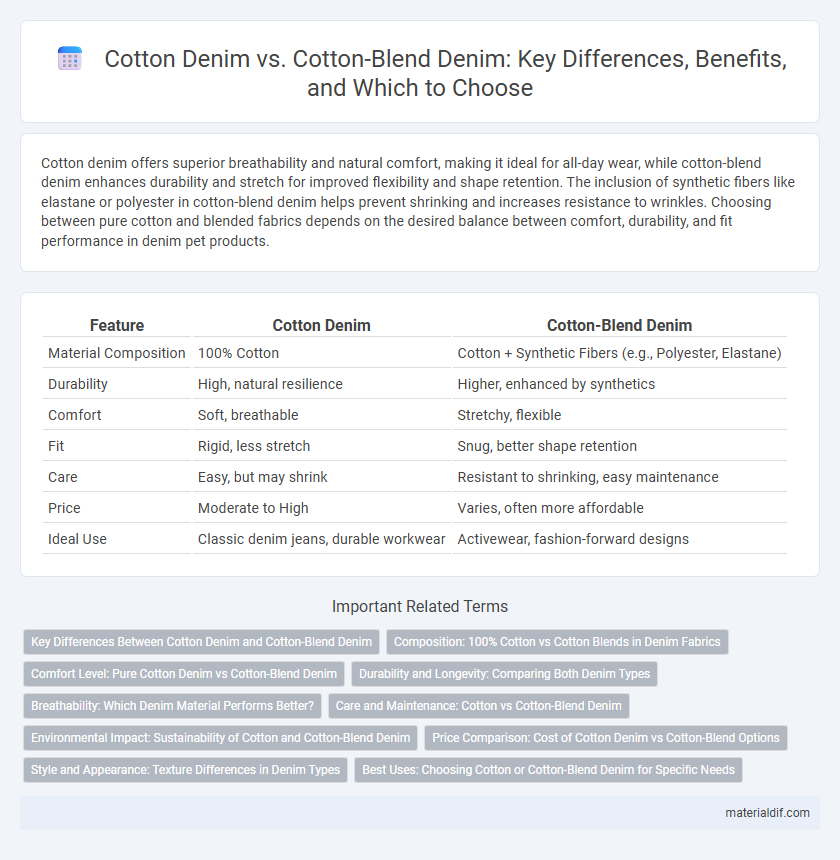Cotton denim offers superior breathability and natural comfort, making it ideal for all-day wear, while cotton-blend denim enhances durability and stretch for improved flexibility and shape retention. The inclusion of synthetic fibers like elastane or polyester in cotton-blend denim helps prevent shrinking and increases resistance to wrinkles. Choosing between pure cotton and blended fabrics depends on the desired balance between comfort, durability, and fit performance in denim pet products.
Table of Comparison
| Feature | Cotton Denim | Cotton-Blend Denim |
|---|---|---|
| Material Composition | 100% Cotton | Cotton + Synthetic Fibers (e.g., Polyester, Elastane) |
| Durability | High, natural resilience | Higher, enhanced by synthetics |
| Comfort | Soft, breathable | Stretchy, flexible |
| Fit | Rigid, less stretch | Snug, better shape retention |
| Care | Easy, but may shrink | Resistant to shrinking, easy maintenance |
| Price | Moderate to High | Varies, often more affordable |
| Ideal Use | Classic denim jeans, durable workwear | Activewear, fashion-forward designs |
Key Differences Between Cotton Denim and Cotton-Blend Denim
Cotton denim is made from 100% natural cotton fibers, offering superior breathability, softness, and durability, making it ideal for traditional denim enthusiasts. Cotton-blend denim incorporates synthetic fibers like polyester or spandex, enhancing stretchability, wrinkle resistance, and shape retention, often providing better comfort and fit for active wear. The key difference lies in fiber composition, with cotton denim excelling in natural feel and longevity, while cotton-blend denim delivers improved flexibility and easier maintenance.
Composition: 100% Cotton vs Cotton Blends in Denim Fabrics
100% cotton denim features natural fibers that provide breathability, durability, and a classic rigid texture essential for traditional denim appeal. Cotton-blend denim incorporates synthetic fibers like elastane or polyester, offering enhanced stretch, flexibility, and wrinkle resistance while maintaining some breathability. The choice between 100% cotton and cotton-blend denim affects fabric performance, fit, and comfort, with cotton blends commonly used for activewear and tailored fits.
Comfort Level: Pure Cotton Denim vs Cotton-Blend Denim
Pure cotton denim offers superior breathability and softness, making it ideal for all-day comfort and reducing skin irritation. In contrast, cotton-blend denim incorporates synthetic fibers like polyester or elastane, enhancing flexibility and durability but sometimes sacrificing the natural comfort of 100% cotton. Consumers seeking a balance between comfort and stretch often prefer blends, while those prioritizing softness and breathability opt for pure cotton denim.
Durability and Longevity: Comparing Both Denim Types
Cotton denim offers superior durability and longevity due to its 100% natural fiber composition, which withstands repeated wear and washing without significant deterioration. Cotton-blend denim incorporates synthetic fibers like polyester or elastane, enhancing stretch and flexibility but potentially reducing overall fabric strength and lifespan. For long-lasting jeans, pure cotton denim generally outperforms blends, though blended fabrics provide added comfort and shape retention.
Breathability: Which Denim Material Performs Better?
Cotton denim excels in breathability due to its 100% natural fiber composition, allowing superior airflow and moisture absorption compared to cotton-blend denim, which contains synthetic fibers like polyester that reduce ventilation. The presence of synthetics in cotton-blend denim often traps heat and limits breathability, making it less comfortable in warm weather conditions. For enhanced comfort and cooling, pure cotton denim outperforms cotton-blend fabrics in breathability and moisture-wicking properties.
Care and Maintenance: Cotton vs Cotton-Blend Denim
Cotton denim requires frequent washing to maintain fabric breathability and softness but is prone to shrinking and fading if not washed cold and dried flat. Cotton-blend denim, often mixed with polyester or elastane, offers enhanced durability and elasticity, reducing wrinkles and shrinkage, and typically requires less frequent washing. Proper care for cotton-blend denim involves gentle machine wash cycles and air drying to preserve fabric stretch and color vibrancy.
Environmental Impact: Sustainability of Cotton and Cotton-Blend Denim
Cotton denim, made from 100% natural fibers, offers biodegradability and lower chemical processing, contributing to reduced environmental pollution compared to cotton-blend denim, which incorporates synthetic fibers like polyester that increase non-biodegradable waste. Sustainable cotton farming practices, such as organic or regenerative cotton, further minimize water usage, pesticide application, and soil degradation, enhancing the eco-friendliness of pure cotton denim. In contrast, cotton-blend denim's synthetic components involve petroleum-based production, higher energy consumption, and microplastic pollution, presenting greater sustainability challenges in denim manufacturing.
Price Comparison: Cost of Cotton Denim vs Cotton-Blend Options
Cotton denim generally commands a higher price due to its 100% natural fiber content and durability, while cotton-blend denim tends to be more affordable by incorporating synthetic fibers that reduce production costs. The addition of materials like polyester or spandex in cotton-blend denim lowers manufacturing expenses and retail prices, offering budget-friendly alternatives without sacrificing some comfort or stretch. Consumers seeking premium quality often invest more in pure cotton denim, whereas those prioritizing cost-effectiveness typically choose cotton-blend options.
Style and Appearance: Texture Differences in Denim Types
Cotton denim offers a crisp, rugged texture with a classic, raw appearance that softens and fades uniquely with wear, enhancing its vintage appeal. Cotton-blend denim features a smoother, more uniform surface due to the integration of synthetic fibers, providing added stretch and durability while maintaining a polished look. These texture differences influence style choices, with pure cotton denim favored for authentic, timeless aesthetics and cotton-blend denim preferred for comfort and modern fit.
Best Uses: Choosing Cotton or Cotton-Blend Denim for Specific Needs
Cotton denim offers superior breathability and durability, making it ideal for classic jeans and heavy-duty workwear that require long-lasting fabric. Cotton-blend denim, often mixed with elastane or polyester, provides enhanced stretch and comfort, perfect for form-fitting apparel like skinny jeans and activewear. Selecting cotton denim suits traditional, rugged uses, whereas cotton-blend denim excels in fashion-forward, flexible garments.
Cotton Denim vs Cotton-Blend Denim Infographic

 materialdif.com
materialdif.com